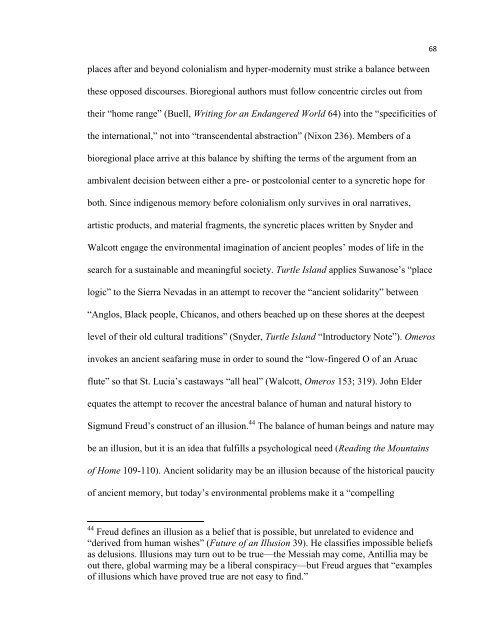RE-INHABITING THE ISLANDS - The University of North Carolina at ...
RE-INHABITING THE ISLANDS - The University of North Carolina at ...
RE-INHABITING THE ISLANDS - The University of North Carolina at ...
You also want an ePaper? Increase the reach of your titles
YUMPU automatically turns print PDFs into web optimized ePapers that Google loves.
places after and beyond colonialism and hyper-modernity must strike a balance between<br />
these opposed discourses. Bioregional authors must follow concentric circles out from<br />
their ―home range‖ (Buell, Writing for an Endangered World 64) into the ―specificities <strong>of</strong><br />
the intern<strong>at</strong>ional,‖ not into ―transcendental abstraction‖ (Nixon 236). Members <strong>of</strong> a<br />
bioregional place arrive <strong>at</strong> this balance by shifting the terms <strong>of</strong> the argument from an<br />
ambivalent decision between either a pre- or postcolonial center to a syncretic hope for<br />
both. Since indigenous memory before colonialism only survives in oral narr<strong>at</strong>ives,<br />
artistic products, and m<strong>at</strong>erial fragments, the syncretic places written by Snyder and<br />
Walcott engage the environmental imagin<strong>at</strong>ion <strong>of</strong> ancient peoples‘ modes <strong>of</strong> life in the<br />
search for a sustainable and meaningful society. Turtle Island applies Suwanose‘s ―place<br />
logic‖ to the Sierra Nevadas in an <strong>at</strong>tempt to recover the ―ancient solidarity‖ between<br />
―Anglos, Black people, Chicanos, and others beached up on these shores <strong>at</strong> the deepest<br />
level <strong>of</strong> their old cultural traditions‖ (Snyder, Turtle Island ―Introductory Note‖). Omeros<br />
invokes an ancient seafaring muse in order to sound the ―low-fingered O <strong>of</strong> an Aruac<br />
flute‖ so th<strong>at</strong> St. Lucia‘s castaways ―all heal‖ (Walcott, Omeros 153; 319). John Elder<br />
equ<strong>at</strong>es the <strong>at</strong>tempt to recover the ancestral balance <strong>of</strong> human and n<strong>at</strong>ural history to<br />
Sigmund Freud‘s construct <strong>of</strong> an illusion. 44 <strong>The</strong> balance <strong>of</strong> human beings and n<strong>at</strong>ure may<br />
be an illusion, but it is an idea th<strong>at</strong> fulfills a psychological need (Reading the Mountains<br />
<strong>of</strong> Home 109-110). Ancient solidarity may be an illusion because <strong>of</strong> the historical paucity<br />
<strong>of</strong> ancient memory, but today‘s environmental problems make it a ―compelling<br />
68<br />
44 Freud defines an illusion as a belief th<strong>at</strong> is possible, but unrel<strong>at</strong>ed to evidence and<br />
―derived from human wishes‖ (Future <strong>of</strong> an Illusion 39). He classifies impossible beliefs<br />
as delusions. Illusions may turn out to be true—the Messiah may come, Antillia may be<br />
out there, global warming may be a liberal conspiracy—but Freud argues th<strong>at</strong> ―examples<br />
<strong>of</strong> illusions which have proved true are not easy to find.‖
















